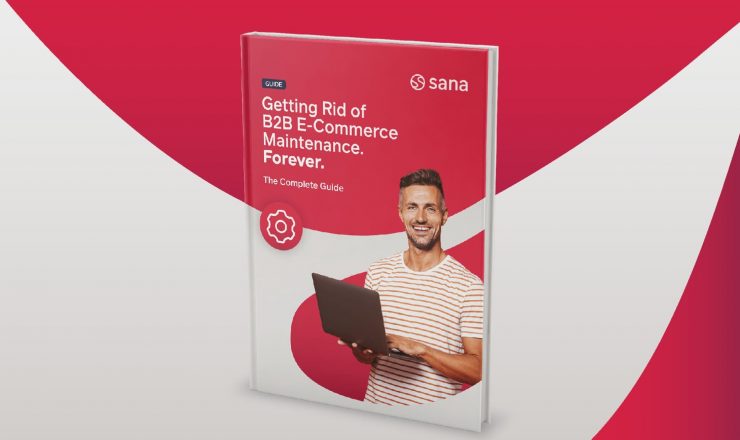

B2B2C, B2X, B2E: Breaking down business barriers
Business lines are blurring — and they have been for some time now. Where B2B and B2C businesses used to stick to their own arenas, technology has made it possible to explore different channels.
The new B2B2C (business-to-business-to-consumer) model (sometimes also referred to as B2X [business-to-x] or B2E [business-to-everyone]) is bringing a lot of big businesses a lot of success. That’s why we’re taking a look at the appeal of B2B2C and offering tips to help you successfully venture out into new sales waters.
Why are B2B businesses expanding to B2C?
According to our 2018-19 research report, 61% of all manufacturers and wholesalers today are now selling directly to consumers.
Businesses stand to benefit from going directly to customers in business-to-consumer and/or direct-to-consumer scenarios instead of going through the supply chain. Cutting out the middleman saves costs for manufacturers, and those better margins have a trickle-down benefit for their end-users. In short, it’s a win-win situation.
Brands are also opening their own stores to reach customers directly, but for slightly different reasons. This approach means brands have tighter control over the brand experience.
Where are businesses expanding into D2C?
From our research, we see that D2C sales are expected to increase, in the following sectors: construction (78%), electronics (68%), household goods and furniture (65%) and packaging materials (65%).
B2B companies who are making the change
We’re already seeing this trend amongst a number of our customers: having both a B2B and a B2C web store on one platform.
Let’s take a look at three examples of companies who have expanded their B2B offerings to stay competitive and reach new customers.
Direct contact with the end-consumer through a new business model:
Sana customer, Stanley & Stella, has been selling sustainable clothing to e-tailers and retailers for years. However in 2017, the manufacturer expanded its business model by opening an omnichannel-focused brick-and-mortar store: allowing their end-consumer to (for example) place their orders via tablets, place personalized orders, and get their own design printed on t-shirts.
Having both a B2B and a B2C web store on one platform:
K-rain, a Sana Commerce customer, made a strategic move by launching two web stores on a unified platform—a customer-facing (B2C) portal and a dedicated B2B portal for their distributor network. This initiative had a huge impact on their customer service and sales teams, thanks to automated order management and customer self-service capabilities. As a result, their team could now focus on cross- or upselling, as well as on having a meaningful impact on their channel partner relationships.
Providing additional services to the end-consumers:
Providing additional services to the end-consumers: Sana customer, Smartwares, has several B2C websites which all allow the end-consumer to use these web stores to return their products themselves – without having to go to their retailer first.
D2C – expanding competition?
Our research has shown that D2C has an influence on the way business is done. Only 4% of the companies we surveyed said that they do not see any influence of D2C within their industry. The majority expect to see increased competition and a disruption of their sales channels. However, 24% expect this disruption and increased competition to be good for the marketplace.
In short, D2C is often regarded as a threat, but it doesn’t have to be. Recent stats and figures reveal that D2C sales will not cause any significant conflicts in the B2B market, despite what many companies have feared. The data shows that:
- 54% of manufacturers and their retailers saw an increase in sales through D2C. What’s the reason for this? Distributors are handling the larger orders that come through.
- 27% from the distributors feel that this is the best way for them to focus on profitable projects, while manufacturers can focus on smaller orders.
- 14% of distributors can now measure the success of new products by testing them with their end-consumers, thanks to D2C sales
The flip side: B2C retailers entering the B2B world
Just as we’re seeing B2B organizations expanding their reach to retail, there are also a number of notable retail businesses trying their hand at B2B, to great success.
After all, as B2B businesses move online and start targeting consumers, it only makes sense that retail competitors will also want the added benefit of a broader audience (and the increased profit margins don’t hurt either).
These scenarios present their own challenges. Putting on the wholesaler hat comes with the added responsibilities of procurement, complex orders and pricing, BOM/kitting, to name a few. The businesses do have the advantage of being more experienced with branding, user experience and marketing, though — areas that are often challenging to B2B companies expanding to B2C.
B2B2C: Cornerstones for maximizing your business opportunities
Perhaps the business model of the future, business-to-business-to-consumer refers to scenarios with blurred lines. As more businesses straddle the line between retail and B2B, it is becoming imperative to have a web store solution that allows them the flexibility to do both, and do them well.
Below are the key cornerstones for your expansion strategy:
1. Get your partners involved
Be transparent to all your retail partners, from suppliers to manufacturers. According to a recent Forrester report, many brands have become successful because they were as transparent as possible to the retail partners involved in their business and supply chain. Discuss your goals with your partners and make sure they’re involved in the process. Here are some examples of how this can be done:
- Let your partners share in the success of your web store
- Offer your partners products and services to your customers
- Feed leads to your partners If you get your partners involved you can avoid conflicts and turn the relationship into a win-win for both parties.
2. Focus on customer experience
Offering an excellent customer experience is an excellent way to keep clients coming back, whether they’re buying for business or pleasure. Must-have features for B2B2C web stores include:
• Usability: this covers factors like load speed, page structure, and graphic design. Is your web store easy to navigate? Can your clients find what they’re looking for?
• Relevant content: we like to follow the 3 C’s: clear, captivating, and concise.
• Consistency: make sure your customers are getting the same messaging across channels.
• Speed: finding information, placing an order and making a payment should be easy and fast.
• Security: from tested and certified e-commerce software to firewalls, IP restriction, and VPN, you don’t want to put your customers’ data (or your business) at risk.
• Self-service: 24/7 access, the ability to place orders, check on shipping status, pay invoices, and get information at their convenience are must-haves for today’s customer.
• Personalization: Once you’ve put the right e-commerce platform in place and have communicated changes to your partners, the next step is to think about how to put personalization, order management, and logistics into practice. With personalization, you should strive to give your customers the same “Amazon-like” experience they’ve come to expect. When it comes to order management and logistics, keep both large and small orders in mind, and be prepared to cater to one-time and repeat customers. All of these factors are necessary to create and maintain a good relationship with the direct customer.

Customer experience is a huge topic. We have a free guide on customer experience in e-commerce that gives tips and tricks for providing your clients a seamless online buying experience.
3. Mobile responsiveness
We’re in the age of the smartphone, and the sooner businesses adapt, the sooner they’ll reap the benefits.
Besides increasing conversions and sales and improving your customer experience, mobile optimization can also mean new and powerful tools for your sales force. B2B sales apps make it possible for sales agents to take their wares with them in the form of a tablet, and good B2B sales apps make it possible for those same agents to place orders on location, even if they’re offline.
4. Localization technology and expertise
One of the perks of B2B2C is that it widens your potential audience, which often means expanding across borders. This can be great for sales, but it can also present a few challenges.
Localizing marketing and content, translating your web store and documentation, working out shipping and taxes — all of these are hurdles that businesses will face as they expand. Luckily, they can all be made significantly easier to surmount when you have the right software.
Make sure that your web store software comes with the tools you need to easily offer your interface in multiple languages. Ideally, you’ll let your ERP do the heavy lifting by choosing e-commerce software that integrates with it directly. This will ensure your ERP remains your single source of truth and will make it significantly easier to localize your offerings online.
5. Cross-selling and upselling
Your web store should be able to suggest related products on the product page, as well as offer upgrades and alternatives in the shopping cart.
If you sell complex products or products that are often grouped with other products (automotive parts, electronics, etc.), both consumers and business clients will appreciate being guided to additional items they might need or want.
Besides being helpful to customers, cross-selling is an important sales tool. Why not let your web store help out your sales force?
Get more tips on how to manage your product catalog.
6. Get your sales team on board
Your sales team might be thinking that with the start of D2C sales in your organization, they will play a less important role in the sales process. On the contrary, in 80% of cases, human interaction between customers and sales reps is still necessary in D2C. Your sales team should not worry about being deemed obsolete by D2C sales; selling D2C online simply means they will have more time to focus on key accounts and enriching customer relationships.
7. Use data learnings
Did you know that 74% of customers find it frustrating when website content isn’t specifically tailored to their needs? Today’s customers want to maintain a relationship with the brands they love, but it has to come from both sides. Use all the data gathered from your company’s different channels to offer your customers a personalized experience based on demographics, behavioral insights, and more.
8. Flexible, fully integrated platform
As we mentioned earlier, having a flexible e-commerce platform is vital to appealing to both B2B and B2C customers.
Companies do not always have the right technical set-up to start selling online immediately, or struggle with legacy software. That’s why it’s important to have a high-functioning, integrated e-commerce platform that fits with your existing infrastructure. Your team wants to provide your customers a great buying experience, so it’s essential that your team can easily work with your web store.
Where consumers might focus more on an attractive website with a smooth browsing experience and fast checkout and delivery, your B2B clients will have other needs such as personalized catalogs, BOM/kitting, and additional payment options.





